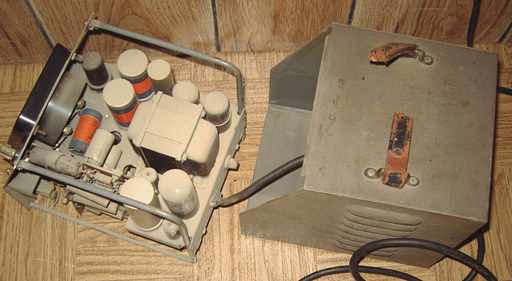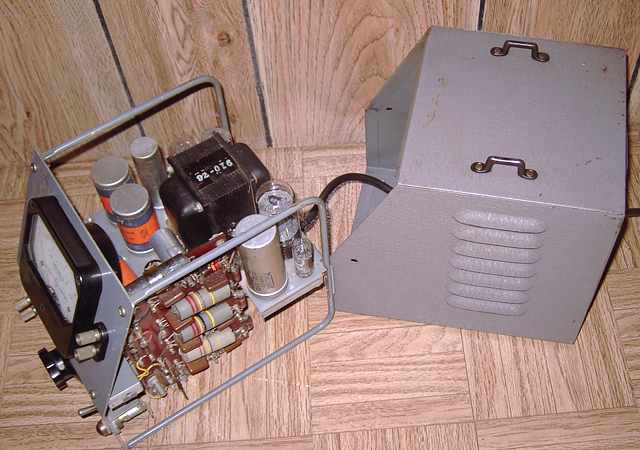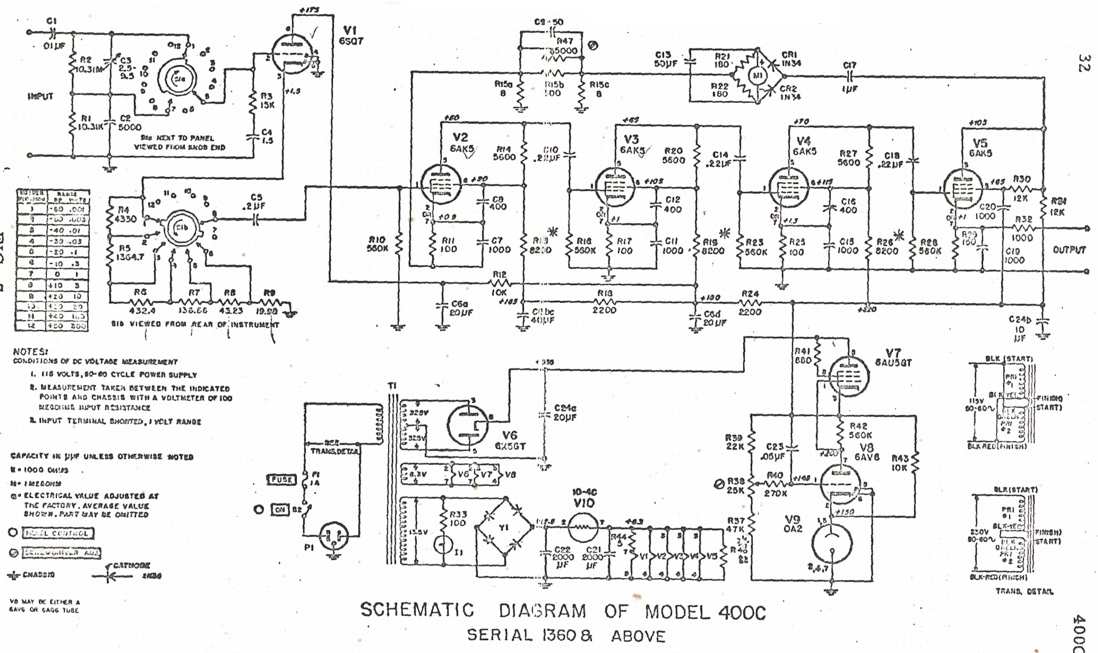
I previously repaired a Hewlett-Packard HP-400C Vacuum Tube Volt Meter without a schematic. The link for the previous 400C has some pictures and more details.
Like others in the HP-400x series, the HP-400C is a wide-band RMS voltmeter. It is capable of reading AC from 1 millivolt full scale to 300 volts full scale like the later 400 models. Its wideband frequency has an upper working limit of 2 Megahertz. Later models have a working limit specification to 4 MHz. The 400C was the first in the series with terminals on the right side for cathode-follower output of its wideband amplifier.
I recently picked up this example, serial number 4370, which happily arrived with a photocopy manual. Model 400C squeezes 10 tubes into the same compact cabinet shape used for the first of the 400x series , the HP-400A introduced in 1942-43. Four of the ten tubes, all 6AK5, (V2-V5) constitute the main amplifier. They are mounted sideways on the phenolic subchassis visible in the pictures below.

The input cathode follower tube is a 6SQ7 (V-1). A low-voltage solid state rectifier supplies DC for the 6AK5 quad and the 6SQ7. An amperite ballast tube (V-10) is included to maintain filament voltage at about 6.3 volts DC. The 6SQ7 has a series resistor for a voltage-starved condition of around 5 volts DC on the filament.
As in all the 400x models, the C model has B+ voltage which is regulated. Power supply tubes include a 6X5 rectifier, a 0A2 regulator, a 6AV6 error amp, and a 6AU5 pass tube. The circuit in this 400C is the later one for serial numbers 1360 and higher. Serial numbers lower than 1360 use a 5Y3 rectifier and a 6V6 or 6Y6 pass tube. Those earlier serial numbers only provide DC filaments for V1 to V3 and do not include the filament ballast. They also used a 7 pin miniature 6AQ6 for V1. Serial numbers beyond 1360 went back to the metal 6SQ7 as used in the older model 400A.

Repairs
This HP-400C had an open power switch, a typical problem with long dormant devices. As usual, I placed the device on its back with the switch pointing up and put contact cleaner into the switch via the bat handle. After working the switch a bit, the problem was solved. I cleaned the voltage range switch also. After a thorough safety check followed by a slow power up while monitoring the current draw and B+ voltage, the meter stabilized but would not go completely to zero, staying consistently at about 1/2 inch up scale regardless of range setting. I suspected the output cap but the problem went away when I pulled the V4 tube, leaving V5 and the output cap in the meter circuit. I learned from my experiences with the HP-400H to connect a scope and/ or a signal tracer to the output terminals when testing. The scope showed some power supply ripple.
I checked the output of the B+ power supply. The scope showed almost no ripple. However, the DC filament supply did show more ripple than I expected. Bridging the two 2200 MFD at 15 volt electrolytics with modern known-good caps solved the problem. I installed those caps leaving the original caps in place.

Interesting uses
The HP-400C was the first of the 400x series to have that very useful cathode-follower wide-band amp output good for audio, VLF, and RF to 2 MHz. With its 50 ohm impedance output, It is useful for lots of tasks around the shop and ham shack, much more than just voltage measurement. Let me know how you have used yours. Check the previous item on the bench, (below) for a couple of examples on how these meters can be used.
The newer Hewlett-Packard HP-400H AC VTVM was the previous item on the bench.